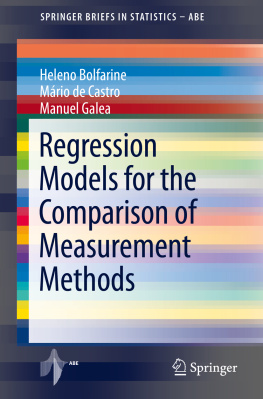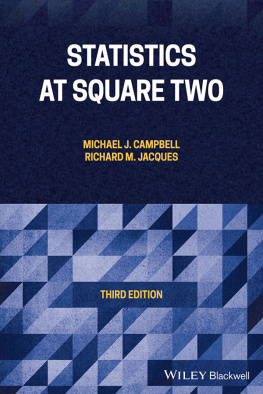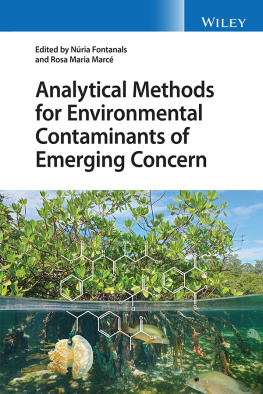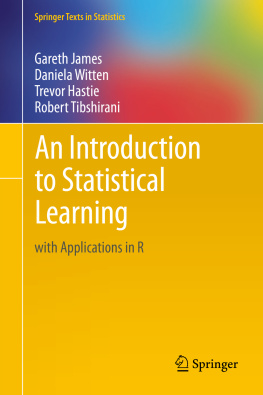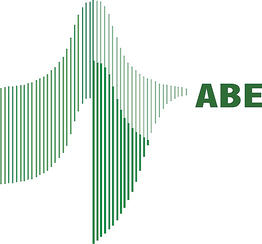SpringerBriefs in Statistics SpringerBriefs in Statistics - ABE
Series Editors
Francisco Louzada
Department of Applied Math and Statistics, University of So Paulo, So Carlos, So Paulo, Brazil
Helio dos Santos Migon
Instituto de Matemtica, Universidade Federal do Rio de Jane, Rio de Janeiro, Rio de Janeiro, Brazil
Gilberto Alvarenga Paula
Instituto de Matemtica e Estatsti, Universidade de So Paulo, So Paulo, So Paulo, Brazil
Francisco Cribari-Neto
Departamento de Estatstica, Universidade Federal de Pernambuco, Recife, Pernambuco, Brazil
SpringerBriefs present concise summaries of cutting-edge research and practical applications across a wide spectrum of fields. Featuring compact volumes of 50 to 125 pages, the series covers a range of content from professional to academic. Typical topics might include:
A timely report of state-of-the art analytical techniques
A bridge between new research results, as published in journal articles, and a contextual literature review
A snapshot of a hot or emerging topic
An in-depth case study or clinical example
A presentation of core concepts that students must understand in order to make independent contributions
SpringerBriefs in Statistics showcase emerging theory, empirical research, and practical application in Statistics from a global author community.
SpringerBriefs are characterized by fast, global electronic dissemination, standard publishing contracts, standardized manuscript preparation and formatting guidelines, and expedited production schedules.
A snapshot of a hot or emerging topic
An in-depth case study
A presentation of core concepts that students must understand in order to make independent contributions
This SpringerBriefs in Statistics ABE subseries aims to publish relevant contributions to several fields in the Statistical Sciences, produced by full members of the ABE Associao Brasileira de Estatstica (Brazilian Statistical Association), or by distinguished researchers from all Latin America. These texts are targeted to a broad audience that includes researchers, graduate students and professionals, and may cover a multitude of areas like Pure and Applied Statistics, Actuarial Science, Econometrics, Quality Assurance and Control, Computational Statistics, Risk and Probability, Educational Statistics, Data Mining, Big Data and Confidence and Survival Analysis, to name a few.
More about ABE: http://www.redeabe.org.br
Heleno Bolfarine , Mrio de Castro and Manuel Galea
Regression Models for the Comparison of Measurement Methods
1st ed. 2020
Heleno Bolfarine
Department of Statistics, University of So Paulo, Sao Paulo, So Paulo, Brazil
Mrio de Castro
Department of Applied Mathematics and Statistics, University of So Paulo, So Carlos, So Paulo, Brazil
Manuel Galea
Department of Statistics, Pontificia Universidad Catlica de Chile, Santiago, RM - Santiago, Chile
ISSN 2191-544X e-ISSN 2191-5458
SpringerBriefs in Statistics
ISSN 2524-6917 e-ISSN 2524-6925
SpringerBriefs in Statistics - ABE
ISBN 978-3-030-57934-0 e-ISBN 978-3-030-57935-7
https://doi.org/10.1007/978-3-030-57935-7
Mathematics Subject Classication (2010): 62Jxx 62Kxx 62Pxx
The Editor(s) (if applicable) and The Author(s), under exclusive license to Springer Nature Switzerland AG 2020
This work is subject to copyright. All rights are solely and exclusively licensed by the Publisher, whether the whole or part of the material is concerned, specifically the rights of translation, reprinting, reuse of illustrations, recitation, broadcasting, reproduction on microfilms or in any other physical way, and transmission or information storage and retrieval, electronic adaptation, computer software, or by similar or dissimilar methodology now known or hereafter developed.
The use of general descriptive names, registered names, trademarks, service marks, etc. in this publication does not imply, even in the absence of a specific statement, that such names are exempt from the relevant protective laws and regulations and therefore free for general use.
The publisher, the authors and the editors are safe to assume that the advice and information in this book are believed to be true and accurate at the date of publication. Neither the publisher nor the authors or the editors give a warranty, expressed or implied, with respect to the material contained herein or for any errors or omissions that may have been made. The publisher remains neutral with regard to jurisdictional claims in published maps and institutional affiliations.
This Springer imprint is published by the registered company Springer Nature Switzerland AG
The registered company address is: Gewerbestrasse 11, 6330 Cham, Switzerland
To my wife Ana Maria Bolfarine
(Heleno Bolfarine)
To my mother (in memoriam)
(Mrio de Castro)
To my parents Lorenza and Enrique (in memoriam), my wife Patricia, and my children Rodrigo and Felipe
(Manuel Galea)
Preface
In this book, we present models and statistical methods for the comparison of measurement methods problem. The need to compare measurement methods or systems, which differ in cost, speed, or other factors, has frequently appeared in various areas of knowledge, such as medicine, biology, analytical chemistry, geology, environmental sciences, psychology, and education, among many others.
In this book, we consider statistical models for continuous data, and unlike the current literature, we adopt functional measurement error models. This background includes the explicit formulation of the functional regression model and the proposal of statistical tests for detection of bias. For parameter estimation and hypothesis testing, we use the maximum likelihood method in the presence of incidental parameters and the corrected score methodology. To the best of our knowledge, both approaches have not been considered in the existing books on this topic. Furthermore, we include tools for the assessment of model adequacy and sensitivity analysis. Although these topics should be an essential part of the analytical method validation problem, they have received only scarce attention in the literature. As an essential element of the book, we furnish R code with functions implementing the techniques and examples, so that practitioners can easily analyze their own data sets.
This book is organized into five chapters. Chapter .
This book is oriented toward the needs of practitioners, laboratory scientists, applied statisticians, geostatisticians, process engineers, geologists, and analysts. It can also be a suitable book for students who specialize in the topics covered in the book.
We appreciate the support of Universidade de So Paulo, SP, Brazil (Heleno Bolfarine and Mrio de Castro) and Pontificia Universidad Catlica de Chile, Chile (Manuel Galea) for providing us with an adequate work environment for the development of our research and, in particular, for the conclusion of this book. Heleno Bolfarine and Mrio de Castro were partially supported by CNPq and FAPESP, Brazil. Manuel Galea was partially supported by grants from CONICYT and FONDECYT, Chile. We are grateful to the Editors of the SpringerBriefs in StatisticsABE Series (F. Louzada, H. S. Migon, G. A. Paula, and F. Cribari-Neto) for the opportunity to disseminate our work. We are indebted to Marcio V. de Castilho for introducing us to applications of the models discussed in this book in geology and in the mining industry. We would like to thank two anonymous reviewers, for their careful reading and valuable comments, which have led to a much improved version of the book. We also thank Robinson dos Santos and Saveetha Balasundaram, from Springer, for guiding us in the preparation of this book.

